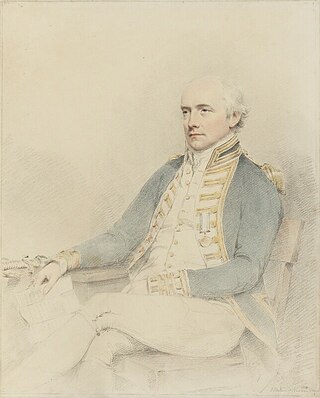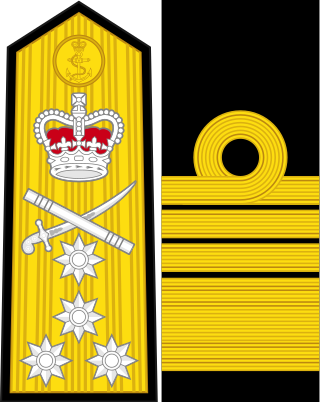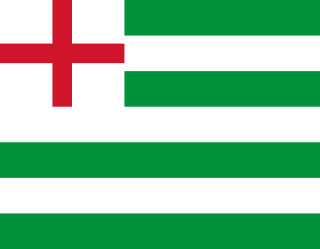
The Battle of Beachy Head, also known as the Battle of Bévéziers, was a fleet action fought on 10 July 1690 during the Nine Years' War. The battle was the most significant French naval victory over their English and Dutch opponents during the war. The Dutch lost a number of ships of the line and three fireships; their English allies also lost one ship of the line, whereas the French did not lose a vessel. Control of the English Channel temporarily fell into French hands but Vice-Admiral Anne Hilarion de Tourville failed to pursue the Anglo-Dutch fleet with sufficient vigour, allowing it to fall back to the Thames.

Vice-Admiral Sir Peter Warren, KB was an Anglo-Irish naval officer and politician who sat in the British House of Commons representing the constituency of Westminster from 1747 to 1752. Warren is best known for his career in the Royal Navy, which he served in for thirty-six years and participated in numerous naval engagements, including most notably the capture of the French fortress of Louisbourg in 1745.

The Battle of Camperdown was a major naval action fought on 11 October 1797, between the British North Sea Fleet under Admiral Adam Duncan and a Batavian Navy (Dutch) fleet under Vice-Admiral Jan de Winter. The battle, the most significant action between British and Dutch forces during the French Revolutionary Wars, resulted in a complete victory for the British, who captured eleven Dutch ships without losing any of their own.

Admiral of the Fleet James Gambier, 1st Baron Gambier, was a Royal Navy officer. After seeing action at the capture of Charleston during the American Revolutionary War, he saw action again, as captain of the third-rate HMS Defence, at the battle of the Glorious First of June in 1794, during the French Revolutionary Wars, gaining the distinction of commanding the first ship to break through the enemy line.

Admiral is a senior rank of the Royal Navy, which equates to the NATO rank code OF-9, outranked only by the rank of admiral of the fleet. Royal Navy officers holding the ranks of rear admiral, vice admiral and admiral of the fleet are sometimes considered generically to be admirals. The rank of admiral is currently the highest rank to which a serving officer in the Royal Navy can be promoted, admiral of the fleet being in abeyance except for honorary promotions of retired officers and members of the Royal Family.

The frigate Gloucester was a Speaker-class third rate, commissioned into the Royal Navy as HMS Gloucester after the restoration of the English monarchy in 1660. The ship was ordered in December 1652, built at Limehouse in East London, and launched in 1654. The warship was conveying James Stuart, Duke of York to Scotland, when on 6 May 1682 she struck a sandbank off the Norfolk coast, and quickly sank. The Duke was among those saved, but as many as 250 people drowned, including members of the royal party; it is thought that James's intransigence delayed the evacuation of the passengers and crew.

Samuel Story was a vice admiral of the Batavian Republic Navy. He commanded the squadron that surrendered without a fight to the Royal Navy at the Vlieter incident in 1799.

The Batavian navy was the navy of the Batavian Republic which was a continuation of the Staatse vloot of the Dutch Republic. Though thoroughly reorganized after the Batavian Revolution of 1795, the navy embarked on several naval construction programs which, at least on paper, made it a serious rival of the Royal Navy during the War of the Second Coalition. However, the Capitulation of Saldanha Bay, the Battle of Camperdown and the Vlieter incident showed that the navy did not measure up to that expectation. Nevertheless, the reorganizations proved to be durable, when the Batavian Republic was succeeded by the Kingdom of Holland, and later, the Kingdom of the Netherlands which makes the present-day Royal Netherlands Navy expected to trace its ancestry through it.

The action of 12 May 1796 was a minor naval engagement during the French Revolutionary Wars between a squadron of British Royal Navy frigates and a frigate and four smaller ships of the Batavian Navy. The British squadron had been detached on the previous day from the British North Sea fleet under Admiral Adam Duncan, which was cruising off the Batavian fleet anchorage at the Texel, while the Batavian squadron was returning to the Netherlands from the Norwegian coast where it had been sheltering since suffering defeat at the action of 22 August 1795 the previous year. As the Batavian squadron neared the Batavian coast, the British squadron under Captain Lawrence Halstead attacked.

The Capitulation of Saldanha Bay was the surrender in 1796 to the British Royal Navy of a Dutch expeditionary force sent to recapture the Dutch Cape Colony. In 1794, early in the French Revolutionary Wars, the army of the French Republic overran the Dutch Republic which then became a French client state, the Batavian Republic. Great Britain was concerned by the threat the Dutch Cape Colony in Southern Africa posed to its trade routes to British India. It therefore sent an expeditionary force that landed at Simon's Town in June 1795 and forced the surrender of the colony in a short campaign. The British commander, Vice-Admiral Sir George Elphinstone, then reinforced the garrison and stationed a naval squadron at the Cape to protect the captured colony.

The Glorious Revolution of 1688 rearranged the political map of Europe, and led to a series of wars with France that lasted well over a century. This was the classic age of sail; while the ships themselves evolved in only minor ways, technique and tactics were honed to a high degree, and the battles of the Napoleonic Wars entailed feats that would have been impossible for the fleets of the 17th century. Because of parliamentary opposition, James II fled the country. The landing of William III and the Glorious Revolution itself was a gigantic effort involving 100 warships and 400 transports carrying 11,000 infantry and 4,000 horses. It was not opposed by the English or Scottish fleets.
The Downs Station also known as the Commander-in-Chief, the Downs or Admiral Commanding at the Downs was a formation of the Kingdom of Great Britain and then the United Kingdom's Royal Navy based at Deal. It was a major command of the Royal Navy from 1626 until 1834.

The Commander-in-Chief, North Sea, was senior appointment and an operational command of the British Royal Navy originally based at Great Yarmouth from 1745 to 1802 then at Ramsgate from 1803 until 1815.

The Admiral of the North also known as Admiral of the Northern Seas and Admiral of the Northern Fleet was a senior English Navy appointment. The Admiral was chiefly responsible for the command of the navy's fleet that operated in the North Sea and off the English coast out of Yarmouth from 1294 to 1412.
The Commander-in-Chief, English Channel or formally Commander-in-Chief, of His Majesty's Ships in the Channel was a senior commander of the Royal Navy. The Spithead Station was a name given to the units, establishments, and staff operating under the post from 1709 to 1746. Following Admiral Lord Anson new appointment as Commander-in-Chief, English Channel this office was amalgamated with the office of Commander-in-Chief, Portsmouth.

The Irish Squadron originally known as the Irish Fleet was a series of temporary naval formations assembled for specific military campaigns of the English Navy, the Navy Royal and later the Royal Navy from 1297 to 1731.

The North Sea Squadron was a temporary naval formation of the Tudor Navy Royal during the sixteenth century operating out of Newcastle, England.
HMS Cracker was an Acute-class gunbrig, launched in 1797. She was sold in 1802.
HMS Princess of Orange was launched in 1796 by the Amsterdam department of the Dutch Navy. In 1799 the British Royal Navy captured her during the Vlieter incident. From 1800 to 1811 she served on the North Sea, Channel, and Irish stations frequently serving as a flagship for various British admirals. Between 1811 and 1820 she served as a powder hulk; she was sold for breaking up in 1822.
Rear-Admiral Alexander Wilson was a Royal Navy officer most notable for his rise to flag rank from his position as a common seaman. Wilson joined the navy in 1777 and soon after became coxswain to Alexander Hood. By 1778 Wilson had been made a midshipman, fighting at the Battle of Ushant and Battle of Cape Henry. Wilson was promoted to lieutenant in 1787 and, continuing to serve with Hood, fought at the Glorious First of June and Battle of Groix before being promoted to commander.















